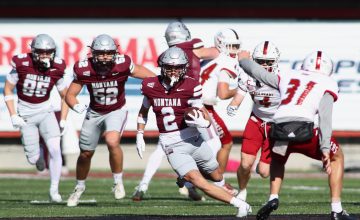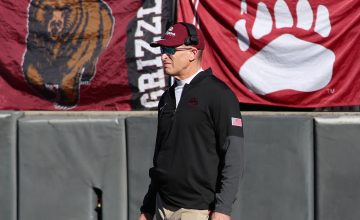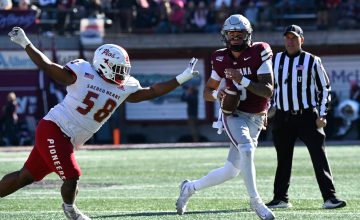For nearly six decades, you knew you’d get another shot at a rival again next year.
Since the Big Sky Conference’s creation in 1963 until the league expanded in 2012, Big Sky schools played a round-robin schedule. A team knew that if they had to make the challenging trip to Bozeman or Missoula it play the Montana State Bobcats or the Montana Grizzlies, at least the next season would include a rematch on their home turf.
With the addition of North Dakota and Southern Utah as full Big Sky members along with Cal Poly and UC Davis as football affiliates, the league schedule is now consistently unbalanced. Teams play eight of the possible 12 Big Sky teams each season and might not play a team for three or four years. For example, Idaho State played at Montana State in 2011 and did not play against the Bobcats again until 2014.
“This is the first time the Griz will be at our place in five years,” said Bruce Barnum, Portland State’s offensive coordinator the last six seasons before being appointed as the team’s interim head coach this off-season. “I like the old way. If I come to your place, I know the next year, you are coming to my place. That’s old school and what everybody knows. This is a little different. I used to look at all our games and not even know who was a conference game. We were playing UC Davis in a non-conference game the other year and I didn’t even know. Just because they put that star there? I’d like to see it organized into two divisions but I don’t know how you do that. But I don’t think the kids care. They just want to play.”
Splitting into divisions has been suggested but never really considered. For one, a two-division league would need a championship game at the end of the year, something the Football Championship Subdivision does not allow because of the 24-team playoff format.
“The problem with splitting divisions is how do you set it up?” Big Sky commissioner Doug Fullerton said during the Big Sky Kickoff media conference in Park City, Utah. “In the FCS, you can’t have a championship game because there’s no time. And that would create a loss and why would you do that when we are probably going to get three or four teams in the playoffs anyways? We wouldn’t do that. So then you have seven in each division, which is an odd number. And you don’t want to play more than eight games because more than eight games, then you don’t have time for your non-conference games. So it’s a real dilemma for us.”
The dilemma has had an influence on the conference race since the league expanded. In 2012, Cal Poly shared the Big Sky crown with Montana State and Eastern Washington. The Mustangs did not play either school nor did they play Montana, a traditional power that has made the playoffs 22 of the last 24 seasons.
But Cal Poly lost in the first round of the playoffs to eventual national runner-up Sam Houston State. This season, the Mustangs drew a schedule devoid of Weber State, Northern Colorado, Northern Arizona and Montana but elected to still play UM in Missoula in a non-conference game. Cal Poly also opens up conference play in Bozeman and has an October gauntlet that includes hosting Iadho State and traveling to Eastern Washington and Southern Utah.
“Our strength of schedule this year is off the charts but a few years ago, it wasn’t and we won the league,” Cal Poly seventh-year head coach Tim Walsh said. “When you get that kind of year year, you better take advantage of it and if you don’t…to me, we are playing Montana in a non-conference game and I think that we should take those opportunities. I really want to play Montana and Montana State and Eastern Washington every year because that’s truly the only way we are ever going to get in the national picture is by playing and beating those teams.”
Northern Colorado, UC Davis and Weber State combined to win five Big Sky Conference games last season. Preseason league favorite Montana State does not play any of the three this fall. The fourth team MSU dodged on the Big Sky schedule is EWU, the other favorite to challenge for the crown. But the Bobcats and the Eagles will stage a rematch of last season’s epic 52-51 non-conference shootout in Bozeman, this time playing it on the red turf in Cheney.
“We always want to play those guys, no matter what, no matter where,” MSU ninth-year head coach Rob Ash said. “We will always try to get them on our schedule even if it’s not a conference game.
Big Sky teams used to schedule non-conference games with members of the Great West frequently. Then the BSC absorbed the four-team league. With the exception of the Southland teams that reside in Texas, San Diego of the Pioneer League is the only FCS team West of the Mississippi that doesn’t play in the Big Sky. Because of this, the league allows Big Sky schools to schedule fellow league members for non-conference games.
“It would be nice if we had more teams out in the West,” said Sac State head coach Jody Sears, who has also coached at EWU and Weber State. “Or to be able to get some home-and-homes with some teams. But you have to be careful what you ask for. We are playing Weber State again this year for the non-conference, which is great. It’s easy travel, good competition and it all goes towards the playoffs anyways. It is what it is. I wish there were more FCS teams out West but there’s no so we make due.”
Non-conference games between Big Sky schools this season include Cal Poly at Montana, MSU at EWU and Sac State at Weber State.
In Ed Lamb’s three seasons coaching in the Big Sky, he’s helped Southern Utah to wins in Missoula and Bozeman. He also played a schedule where he didn’t have to face MSU last season and won’t have to play Montana, Idaho State or Eastern Washington this fall. Still, he thinks his team isn’t getting the chance to hone new rivalries because of the uneven scheduling.
“One of the ways it affects us most negatively is that when we don’t play teams regularly, I think coaches don’t have the opportunity to prepare their teams as well,” Lamb said. “The teams that we play on a regular basis, they expose our weaknesses and know our weaknesses well. We in turn make adjustments and do the same thing to them. We are making each other stronger. The NFL is a classic example. They play the teams in their division two times a year and maybe even in the playoffs. I think for all the benefits for having so many teams in such a big, strong conference that expands so much geographic area and the influence we have in terms of playoff selection numbers, the one disadvantage is that familiarity and being able to attack each other on a consistent basis and learn from each other.”
Jerome Souers is entering his 18th season as the head coach at Northern Arizona. He remembers preparing year in and year out to try to knock off the three top dogs up north. Now his team’s “protected rivalries” ensure that NAU plays Southern Utah and Northern Colorado each year.
The expansion of the Big Sky has diversified the styles played in the league. One week, you could be going against Cal Poly’s vaunted triple option. The next week, you could be facing off against Idaho State’s up-tempo option spread. The next week, you could be facing North Dakota’s ground-and-pound pro-style offense. And the next week, EWU could be trying to stretch the field on you from the opening snap.
“You don’t want to recruit for one game but you look at the different offenses and there’s so many different flavors in our conference that there’s not much carry over each week,” Souers said. “The defenses are at a disadvantage with the number of things they have to see week in and week out and not being able to get good at seeing something. In the old days, you’d see an empty package, about the same from every team. Every team would run power and everyone got better at it and better at stopping it. That’s not the case anymore.”
Jay Hill spent more than a decade coaching in the Mountain West and the Pac 12 as an assistant at the University of Utah. Now he’s the second-year head coach at Weber State and the variability of preparation has been striking.
“Our systems have got to be adaptable and the players you are recruiting have got to be able to fit your scheme more than fit to stop a certain opponent,” said Hill, who’s team doesn’t have to play Montana State, Portland State or Cal Poly this year. “In this league, we probably face as many different types of schemes as any league defensively. One team, you can get pounded and then the next week you are playing the four-wide spread and then the next week you are playing Cal Poly and the triple option. You have to be ready to adapt.”
Fullerton spoke in length at the Big Sky Kickoff about the strong position the Big Sky has established in the West. The league has a formidable geographic reach, a strong television deal with ROOT Sports and a niche in member schools located in community-based towns with a passion for football.
Eastern Washington made the last appearance in the FCS title game, winning the crown in 2010. Since then, the Eagles in 2012 and 2013 advanced to the final four. No other team has advanced passed the quarterfinals. It’s a step back on the national picture from a time when Montana dominated the league and the playoffs, advancing to seven national titles games and winning two crowns between 1995 and 2009. But the number of contenders has increased and the brand of the Big Sky is quickly spreading across the West.
“It’s cool our league gives us the third option for a recruit in the West: Pac 12, Mountain West, Big Sky. That’s it,” said Idaho State head coach Mike Kramer, a coach or player in the Big Sky for most of the last 40 years. “To that end, I like that. I think that’s a positive. The size of the conference should provide us with a stronger presence in the playoffs until we start playing better defense. And that is a personnel issue in our conference across the board at defensive line. And that’s not going to get solved because there are no big guys who run fast who are mean in the West. We do not have those guys in the West. Even in the Pac 12. The Pac 12 has a very strong dearth of defensive lineman. It’s what precludes the Pac 12 from being the preeminent conference in the nation because they have no defensive linemen, big guys who run fast who are willing to submit to the toughness and meanness to play that position. The lifestyle doesn’t exist in the West.
“Until we have that and until we start playing better defense, we won’t be able to dominate on the national scene.”
As UC Davis enters its third year in the league, Ron Gould is entering his third year at the helm for the Aggies. The former Cal running backs coach has seen his team post a 5-3 mark in Big Sky play and last season’s 1-7 campaign. Despite his team’s lumps and the fact that his team doesn’t play Eastern Washington, Montana State or Idaho State this season, Gould doesn’t put much stock in the luck of the draw. And his comments are echoed by most of the coaches around the league.
“It’s out of our control,” Gould said. “The scheduling some years, you play certain teams and other years you are not. The scheduling is what it is. We play in arguably the best conference in the FCS so week in and week out, it’s going to be a battle. You have to scratch and claw for four quarters to give yourself a chance to win. The team that does that is the team that is crowned victorious.”














